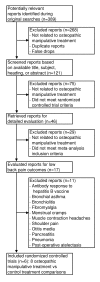Osteopathic manipulative treatment for low back pain: a systematic review and meta-analysis of randomized controlled trials
- PMID: 16080794
- PMCID: PMC1208896
- DOI: 10.1186/1471-2474-6-43
Osteopathic manipulative treatment for low back pain: a systematic review and meta-analysis of randomized controlled trials
Abstract
Background: Osteopathic manipulative treatment (OMT) is a distinctive modality commonly used by osteopathic physicians to complement their conventional treatment of musculoskeletal disorders. Previous reviews and meta-analyses of spinal manipulation for low back pain have not specifically addressed OMT and generally have focused on spinal manipulation as an alternative to conventional treatment. The purpose of this study was to assess the efficacy of OMT as a complementary treatment for low back pain.
Methods: Computerized bibliographic searches of MEDLINE, EMBASE, MANTIS, OSTMED, and the Cochrane Central Register of Controlled Trials were supplemented with additional database and manual searches of the literature. Six trials, involving eight OMT vs control treatment comparisons, were included because they were randomized controlled trials of OMT that involved blinded assessment of low back pain in ambulatory settings. Data on trial methodology, OMT and control treatments, and low back pain outcomes were abstracted by two independent reviewers. Effect sizes were computed using Cohen's d statistic and meta-analysis results were weighted by the inverse variance of individual comparisons. In addition to the overall meta-analysis, stratified meta-analyses were performed according to control treatment, country where the trial was conducted, and duration of follow-up. Sensitivity analyses were performed for both the overall and stratified meta-analyses.
Results: Overall, OMT significantly reduced low back pain (effect size, -0.30; 95% confidence interval, -0.47 - -0.13; P = .001). Stratified analyses demonstrated significant pain reductions in trials of OMT vs active treatment or placebo control and OMT vs no treatment control. There were significant pain reductions with OMT regardless of whether trials were performed in the United Kingdom or the United States. Significant pain reductions were also observed during short-, intermediate-, and long-term follow-up.
Conclusion: OMT significantly reduces low back pain. The level of pain reduction is greater than expected from placebo effects alone and persists for at least three months. Additional research is warranted to elucidate mechanistically how OMT exerts its effects, to determine if OMT benefits are long lasting, and to assess the cost-effectiveness of OMT as a complementary treatment for low back pain.
Figures



Similar articles
-
Herbal and dietary therapies for primary and secondary dysmenorrhoea.Cochrane Database Syst Rev. 2001;(3):CD002124. doi: 10.1002/14651858.CD002124. Cochrane Database Syst Rev. 2001. Update in: Cochrane Database Syst Rev. 2016 Mar 22;3:CD002124. doi: 10.1002/14651858.CD002124.pub2. PMID: 11687013 Updated.
-
Spinal manipulation for primary and secondary dysmenorrhoea.Cochrane Database Syst Rev. 2001;(4):CD002119. doi: 10.1002/14651858.CD002119. Cochrane Database Syst Rev. 2001. Update in: Cochrane Database Syst Rev. 2004;(3):CD002119. doi: 10.1002/14651858.CD002119.pub2. PMID: 11687141 Updated.
-
A rapid and systematic review of the clinical effectiveness and cost-effectiveness of topotecan for ovarian cancer.Health Technol Assess. 2001;5(28):1-110. doi: 10.3310/hta5280. Health Technol Assess. 2001. PMID: 11701100
-
Osteopathic intervention in chronic non-specific low back pain: a systematic review.BMC Musculoskelet Disord. 2013 Apr 9;14:129. doi: 10.1186/1471-2474-14-129. BMC Musculoskelet Disord. 2013. PMID: 23570655 Free PMC article.
-
Impact of osteopathic manipulative techniques on the management of dizziness caused by neuro-otologic disorders: systematic review and meta-analysis.J Osteopath Med. 2022 Oct 12;123(2):91-101. doi: 10.1515/jom-2022-0119. eCollection 2023 Jan 1. J Osteopath Med. 2022. PMID: 36220009
Cited by
-
Aquatic Osteopathy Treatment Assessment by Infrared Thermography on Healthy Subjects After Thermoneutral Water Immersion.J Chiropr Med. 2019 Sep;18(3):188-197. doi: 10.1016/j.jcm.2019.07.007. Epub 2020 Aug 21. J Chiropr Med. 2019. PMID: 32874158 Free PMC article.
-
Osteopathic Manipulation in the Management of Chronic Pain: Current Perspectives.J Pain Res. 2020 Jul 20;13:1839-1847. doi: 10.2147/JPR.S183170. eCollection 2020. J Pain Res. 2020. PMID: 32765058 Free PMC article. Review.
-
Osteopathic Considerations for Peripheral Neuropathy Due to Concomitant Diffuse Idiopathic Skeletal Hyperostosis Syndrome and Lumbar Epidural Lipomatosis: Case Report.Interact J Med Res. 2019 Nov 20;8(4):e14607. doi: 10.2196/14607. Interact J Med Res. 2019. PMID: 31746769 Free PMC article.
-
Osteopathic manipulative treatment in patients with low back pain.Clin Rheumatol. 2011 Jun;30(6):871-2; author reply 873. doi: 10.1007/s10067-011-1739-9. Epub 2011 Apr 15. Clin Rheumatol. 2011. PMID: 21494808 No abstract available.
-
Objectivation of an Educational Model in Cranial Osteopathy Based on Experience.Medicina (Kaunas). 2021 Mar 5;57(3):246. doi: 10.3390/medicina57030246. Medicina (Kaunas). 2021. PMID: 33808011 Free PMC article.
References
-
- Licciardone JC, Herron KM. Characteristics, satisfaction, and perceptions of patients receiving ambulatory healthcare from osteopathic physicians: a comparative national survey. J Am Osteopath Assoc. 2001;101:374–385. - PubMed
-
- Licciardone JC. Awareness and use of osteopathic physicians in the United States: results of the Second Osteopathic Survey of Health Care in America (OSTEOSURV-II) J Am Osteopath Assoc. 2003;103:281–289. - PubMed
-
- Agency for Health Care Policy and Research [AHCPR] Clinical Practice Guideline 14. Rockville, MD, US Department of Health and Human Services; 1994. Acute low back problems in adults.
-
- Kuchera ML, DiGiovanna EL, Greenspan PE. Efficacy and complications. In: Ward RC, editor. Foundations for Osteopathic Medicine. 2. Philadelphia, PA: Lippincott Williams & Wilkins; 2003. pp. 1143–1152.
Publication types
MeSH terms
Grants and funding
LinkOut - more resources
Full Text Sources
Medical

